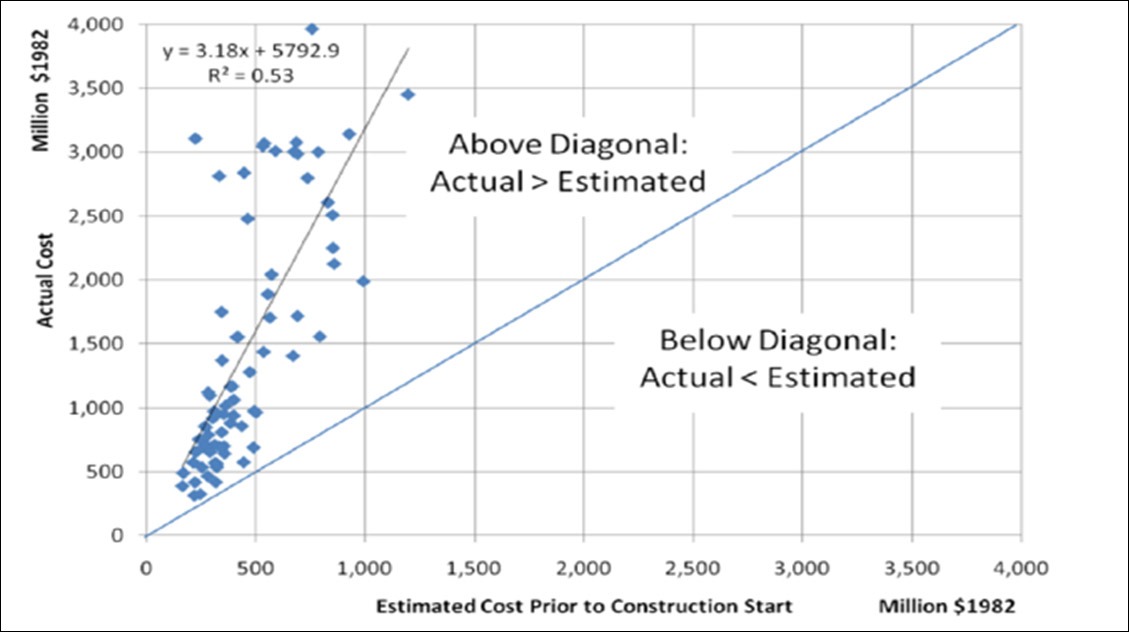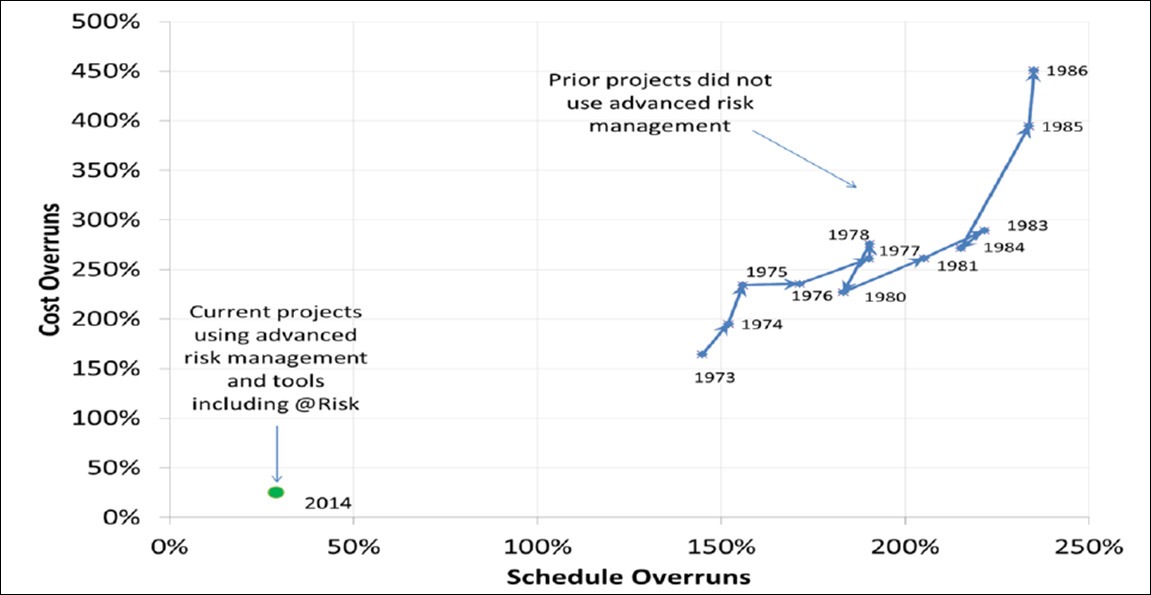
In 2008, a US nuclear power company signed engineering, procurement and construction (EPC) contracts for three power plants in China, South Carolina and Georgia. The total expected project costs for all three projects was over $30 billion. Based on historical nuclear industry project delivery performance, the company recognized that it had significant cost overrun risk exposure; the average cost of nuclear power plants constructed in the US was 300% of the planned cost at the start of construction. The concurrent design and construction of the power plants presented further technical and supply chain risks. The company decided to implement an advanced risk management program that included the use of powerful analytical tools such as Palisade’s @RISK. Since implementing @RISK into their project management, the nuclear power company has reduced cost overruns by roughly 80% relative to the historical trend.
A Costly Reality
One of the largest threats facing nuclear power generation is high costs and high cost overruns, and inadequate risk management is often a significant cause of these issues. When risks are not property identified and mitigated, incidents occur that result in substantial costs to the involved company. Moreover, these incidents lead to regulatory responses that increase expenses across the entire industry. The oil and gas and the nuclear industries have both recently come under significant regulatory and public scrutiny due to the recent Macondo and Fukushima incidents that occurred respectively in both industries.

Cost Overruns in Nuclear Power Infrastructure Projects
Inadequate management of risk has enormous economic ramifications. “The actual costs are always higher than estimated,” says Dr. Sola Talabi, Risk Management Professor at Carnegie Mellon University and Risk Management Consultant for Pittsburgh Technical, a risk management firm. “On average, those costs are about three times more expensive. That’s like saying you’re going to build a house for $100K, and it ends up costing you $300K."
A New Approach to Planning
Because of the Three-Mile Island accident in 1979, U.S. nuclear power plant construction had ground to a halt due to unfavorable public sentiment. Finally, almost 30 years later, the first EPC contracts for new plants were signed by a major U.S. nuclear power company in 2008. The total expected project cost for the three EPC projects was over $30 billion. Hoping to avoid the abysmal track record of cost overruns in their industry, they wanted to use a new and improved risk-management approach to their planning process—so they hired Dr. Talabi to serve as Nuclear Power Plant Risk Manager. “They knew what the history had been with these projects, and they didn’t want it to happen again,” says Dr. Talabi.
In previous power plant construction projects, risk management was only an objective of project managers. This time, risk management was both an objective and a function; the company created a dedicated risk organization whose only role was to manage risk. Dr. Talabi summarizes the role of the risk organization as providing what he calls “triple A risk management” and defines it as “proving Awareness, Assessment, and Action on issues of uncertainty that affect planned performance.” He continues, “When they looked at how much money was lost historically due to risk, they realized it was worth the investment of creating an entire, separate risk organization. I was hired to assist in establishing the risk organization, which included hiring the people, defining the processes and selecting the tools. For tools, I picked advanced risk management tools, including Palisade’s @RISK.”
Using @RISK
Previous risk planning methods used in the estimation of nuclear power costs were deterministic and did not include any measures of uncertainty. “Best guesses were made and were included as fixed non-variable values,” says Dr. Talabi. “Hence, there was no way to perform sensitivity analysis to determine the effect of changes in the values, because they were fixed values.” Also, previous models failed to make correlations between variables.
Armed with @RISK, Dr. Talabi and his risk management team were able to characterize the uncertainty associated with cost items and perform quantitative risk analysis with the Monte Carlo simulation method. Their model inputs included the following (among other parameters):
*Distributions representing the expected range of eventual project costs based on historical costs *Probability for a risk event to occur *Characterization of the cost uncertainty of each major cost item as a range of possible values based on historical cost variability for the particular item *Correlations between the applicable variables
The outputs from the models provided Dr. Talabi with a description of the uncertainty associated with meeting various project cost and schedule objectives.
Additionally, using sensitivity analysis tools, Dr. Talabi identified the drivers of cost overruns and the errors made in prior cost estimation of nuclear power plants. In their analysis, they found that certain estimation heuristics that are applicable for small projects are not directly transferrable to large complex projects. For example, they performed a sensitivity analysis of historical data to determine the following:
Expected economies of scale did not result in lower cost for larger reactors: “We found that the opposite occurred,” says Dr. Talabi. “The larger the plants, the more expensive they were on a dollar per kilowatt of generation capacity… It’s about complexity. If there’s an accident, the expected radiological impact becomes exponentially higher, but it’s also tied to human perception that there would be greater risk.”
Expected effects of experience did not result in lower cost of construction: Dr. Talabi and his team found that the effect of building multiple reactors did not lead to cost reduction, as there is a high level of expertise and infrastructure required to enter the nuclear construction industry, and hence the additional expertise gained by constructing multiple plants has a minimal effect on performance. (This phenomenon has been noticed in other fields where there is significant task complexity.)
Inaccurate model assumptions: There were correlations between cost and schedule estimation models that were not reflected in the historical nuclear plant estimation models. Dr. Talabi found that the exclusion of these correlations created estimation errors.
Another noteworthy finding from the sensitivity analysis: The greatest risk driver was one that, previously, had never been listed as a top risk: supply chain issues. “They were never at the top of the list in historical assessments,” says Dr. Talabi. “People weren’t paying attention to it. So now, knowing that it drives the majority of the costs, it allows the company to take action and have a supply chain management program that helps prevent these cost overruns. Now, the company has people in place whose sole responsibility is to manage supply chain issues.”
Dr. Sola Talabi
Risk Management Professor, Carnegie Mellon University
Dramatic Results
Thanks to this analytical, @RISK-driven approach, Dr. Talabi and the risk organization were able to dramatically change the course of cost overrun for these nuclear power plant projects—by up to 80%, as illustrated in Figure 2.

Comparison of Project Performance with/without Advanced Risk Management Tools
“While we still have cost overruns, it’s nothing like what we had before,” says Dr. Talabi. “I think it’s very important for decision-makers to realize that the rampant cost overruns of the past can be much better managed using tools like @RISK.”
Beyond that compelling point, Talabi has more praise for the software. “One of the key benefits of Palisade’s software is the ability to plug into familiar systems such as Microsoft Excel, hence there is a reduced learning curve to get familiar with the Palisade tools,” he says. “We also find the various types of sensitivity analyses to be amongst the most beneficial features because these provide insights into models that cannot be readily appreciated. The sensitivity analysis also allows for prioritization of the importance of various issues. This ensures that managers are focusing on the most important items that may affect the performance of their projects.”
